Research Article | DOI: https://doi.org/10.31579/2835-7957/136
An Understanding of FIKR (Facet, Insight, Knowledge and Resilience) to the application of Personality Traits in Plastic Pollution in Malaysia: A Public Perception Study
- Chee Kong Yap 1*
- Chee Seng Leow 2
- Muhammad Adam Hazieq 1
- Hew Tze Yik Austin 1
- Maisarah Defififaldi 1
- Khadijah Masran 1
- Nik Izzah Atirah Nek Ramlan 1
- Muhammad Ezzafel Shafu Azhar 1
- Rosimah Nulit 1
- Wan Mohd Syazwan 1
- Wing Sum Vincent Leong 2
1Department of Biology, Faculty of Science, Universiti Putra Malaysia, 43400 UPM Serdang, Selangor, Malaysia
2Humanology Sdn Bhd, 73-3 Amber Business Plaza, Jalan Jelawat 1, 56000 Kuala Lumpur, Malaysia
*Corresponding Author: Chee Kong Yap, Department of Biology, Faculty of Science, Universiti Putra Malaysia, 43400 UPM Serdang, Selangor, Malaysia.
Citation: Chee K. Yap, Chee S. Leow, Muhammad A. Hazieq, Yik Austin HT, Maisarah Defififaldi, et al, (2025), An Understanding of FIKR (Facet, Insight, Knowledge and Resilience) to the application of Personality Traits in Plastic Pollution in Malaysia: A Public Perception Study, Clinical Reviews and Case Reports, 4(6); DOI:10.31579/2835-7957/136
Copyright: © 2025, Chee Kong Yap. This is an open-access article distributed under the terms of the Creative Commons Attribution License, which permits unrestricted use, distribution, and reproduction in any medium, provided the original author and source are credited.
Received: 06 October 2025 | Accepted: 23 October 2025 | Published: 03 November 2025
Keywords: plastic pollution; perception; personality traits; fikr; plastic waste management
Abstract
The objectives of this study were a) to assess the public perception of plastic pollution in Malaysia and b) to understand the public perception outcomes from the point of view of FIKR (facet, insight, knowledge, and resilience) personality traits. The questionnaire study shows how the general population views plastic pollution changes as their understanding and knowledge of the problem increases. The way the general population views plastic pollution changes as their understanding and knowledge of the problem increases. Although there is still much to be made in altering consumer behaviour and decreasing plastic waste, it is clear that a growing number of individuals are seeing the detrimental impact of plastic pollution on the environment and are actively working to address it. Through continuous activism and education, there is optimism for a shift towards more sustainable behaviours and a purer, healthier planet for future generations. Collaboration among governments, communities, and individuals is vital to address this pressing issue and provide innovative solutions that will have a beneficial effect on the environment. It can be concluded that the public perception of plastic pollution is influenced by personality traits such as facet, insight, knowledge, and resilience. This, combined with access to accurate information and effective communication strategies, can help shape public perception towards a greater concern for plastic pollution and drive individuals towards sustainable actions and behaviours.
Introduction
Introduction
The plastic industry has been expanding globally due to the growing demand for plastic products in various sectors, including packaging, automotive, construction, and consumer goods. Plastic is an incredibly versatile synthetic material, with over 2 million plastic bags and bottles used daily in the packaging industry [1]. There is a widespread demand for plastics across various sectors, with the packaging industry leading at 36%, followed by building and construction at 22%. The remaining 42% is utilized in other significant sectors like electronics, furniture, transport, agriculture, medical, toys, and more [1]. Moreover, the onset of the COVID-19 pandemic has led to a rise in the use of disposable plastics and personal protective equipment (PPE) like gloves and face masks, contributing to macro- and micro-plastic pollution [2]. For example, in February 2020, China witnessed a surge in face mask production to 116 million per day, marking a twelvefold increase compared to the pre-COVID-19 era [2].
Malaysia is one of the leading nations globally in plastic production, with over 1300 plastic manufacturing companies in the country. Malaysia generates approximately 0.5–1.9 kg of municipal waste per capita per day, with plastic waste constituting the second-highest proportion at 24% among various waste categories [3-4]. The country heavily relies on landfill disposal and domestic incineration systems, leading to heightened plastic pollution that adversely affects the environment and human health. Additionally, Malaysia faces a challenge with its notably low recycling rate, which is insufficient to manage the substantial volume of plastic waste generated [4]. Even though plastics have become an omnipresent human-made commodity integral to various aspects of modern culture and daily routines, their widespread use, driven by the obvious benefits of durability and lightness, has become an issue of concern for Malaysia's environment and public health [5]. Plastic waste, littering, and unauthorized disposal of plastic debris are all common problems in Malaysia, putting strain on waste management systems and the overall ecosystem [5-12]. Plastic pollution has become a pressing global issue, raising concerns about its impact on the environment, human health, and the economy [13-18]. The ubiquity of plastic debris and its interaction with marine wildlife through entanglement and ingestion is one of the most commonly reported impacts. Furthermore, the quantification and measurement of plastic pollution present challenges due to discrepancies in terminology, reporting units, and methodologies [19-22]. Additionally, the degradation of plastic items through weathering contributes to the fragmentation of plastics into microplastic pieces, which can be smaller than a grain of sand [23-30] The growth in Malaysia's population and swift industrial development since the post-independence period have led to an escalation in solid waste production [5]. There is an anticipated increase of at least 3 million tonnes in solid waste generation from 2015 to 2020 [5]. In one study conducted by Chin et al. [4], they conducted a Knowledge, Attitude, and Practices (KAP) study to address plastic pollution. The research assessed Malaysians' understanding, attitudes, and behaviours regarding plastic pollution, revealing that respondents generally scored low in knowledge, high in attitude, and low in practice across various socio-demographic groups. Notably, older respondents were more likely to be aware of plastic pollution. The individuals with higher levels of education, especially those who studied environmental subjects, also exhibited a greater knowledge of plastic pollution [4]. Since there are limited studies on the public's perception of plastic waste, the objectives of this study were a) to assess the public's perception of plastic pollution in Malaysia and b) to understand the public's perception outcomes from the point of view of FIKR (facet, insight, knowledge, and resilience) personality traits.
Methodology
In conducting a scientific methodology survey, a structured approach was followed to gather data from a sample of 200 participants within the public domain. The survey instrument, consisting of carefully formulated questions, aimed to elicit specific information relevant to the research objectives. The survey link was disseminated through diverse social media platforms [31-32], including WhatsApp, Instagram, and another platform (designated as 'X') to ensure a representative sample. The data was collected from 21st October to 7th November 2023. The distribution process adhered to ethical considerations, ensuring informed consent and privacy protection. The survey design incorporated validated methodologies to enhance the reliability and validity of the responses. The collected data underwent systematic analysis, employing statistical tools to derive meaningful insights. Rigorous adherence to scientific principles throughout the survey process enhances the credibility and generalizability of the findings, contributing to the robustness of the research endeavour.
Results
Section A: Demographic Profile
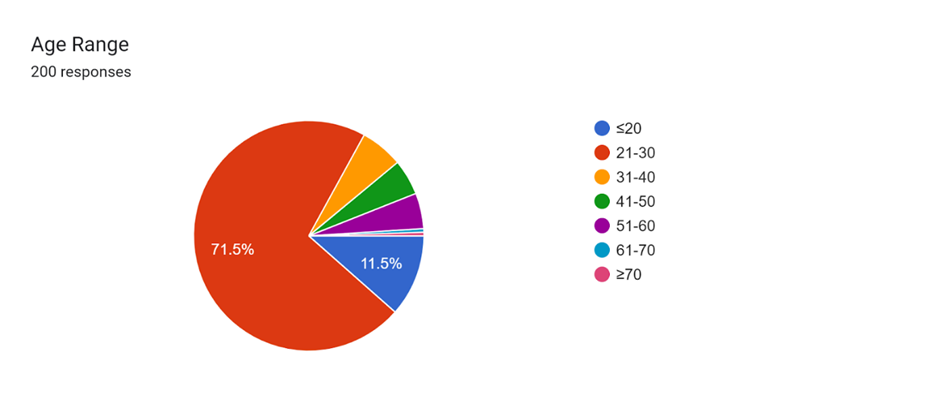
Figure 1: Pie chart of age range of respondents.
From the 200 respondents, the highest percentage of respondents is from the age range of 21 to 30 years old. The lowest percentage of respondents are from the age group of 61 to 70 and above 70 years of age.
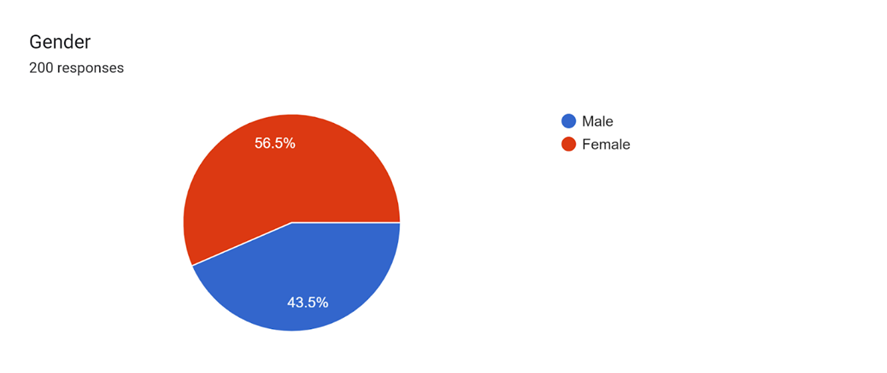
Figure 2: Pie chart of genders of respondents
From the above pie chart, more than half of the respondents are female respondents.

Figure 3: Pie chart of ethnicity of respondents
From the pie chart, we can conclude that both Malays and Chinese almost reached half of the number of respondents.

Figure 4: Pie chart of economic status of respondents
Three of the economic statuses were categorised in the questionnaire and 62.5% of respondents were under the category of M40 status.
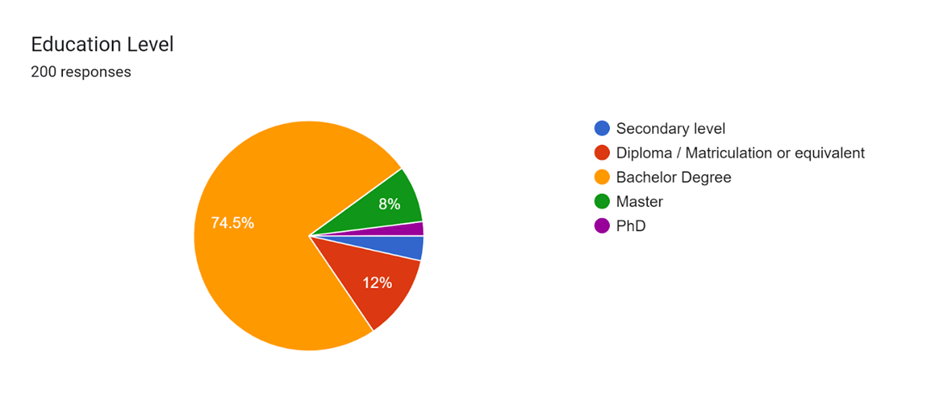
Figure 5: Pie chart showing the education level of respondents
The educational level of the respondents is the highest at bachelor level whereas the lowest number of respondents falls in the category of PhD level.

Figure 6: Pie chart showing the education background of respondents
The highest number of respondents has a science background of education whereas others is the lowest percentage which is only 12% of the respondents.

Figure 7: Pie chart showing the demographic living area of respondents
Most of the respondents live in sub-urban areas with people living in the less populated area with 49.5% overall while 35.5% of the respondents living in the urban area.
Section B: Opinion On Plastic Pollution

Figure 8: Pie chart of respondents’ opinion whether plastic pollution is an environmental issue in Malaysia
Most Malaysians are aware that plastic pollution is an environmental issue in Malaysia since Yes have the highest percentage with 97% which almost all respondents acknowledge the plastic pollution in Malaysia.

Figure 9: Bar chart showing the respondents’ answers on the cause of plastic pollution
Most of the respondents agree that littering is the main cause of water pollution since it has the highest percentage of 77.5%. Industrial activities like manufacturing and packaging production where the plastic is generated got 113 votes.
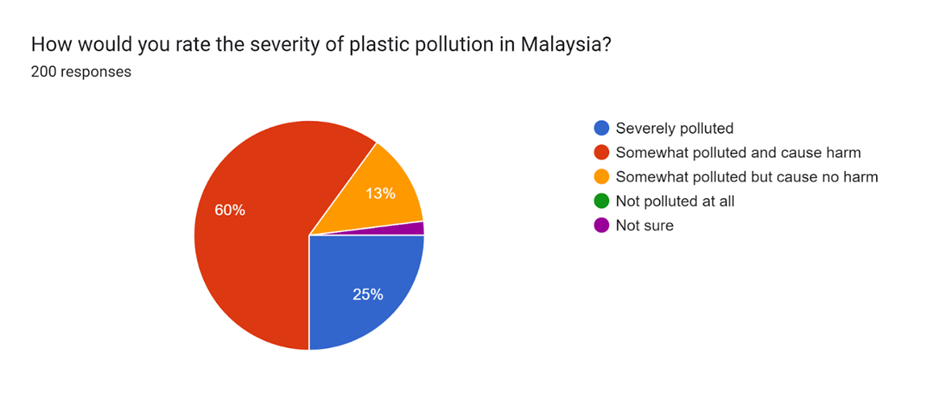
Figure 10: Pie chart showing the percentage of respondents’ answer on the severity of plastic pollution in Malaysia?
More than half of the respondents voted that plastic pollution in Malaysia is somewhat polluted and causes harm to the community and environment while a tiny percentage of respondents are not sure about the condition of plastic pollution in Malaysia with 2%.
Section C: Public Perception and Knowledge Towards Plastic Pollution Management in Malaysia
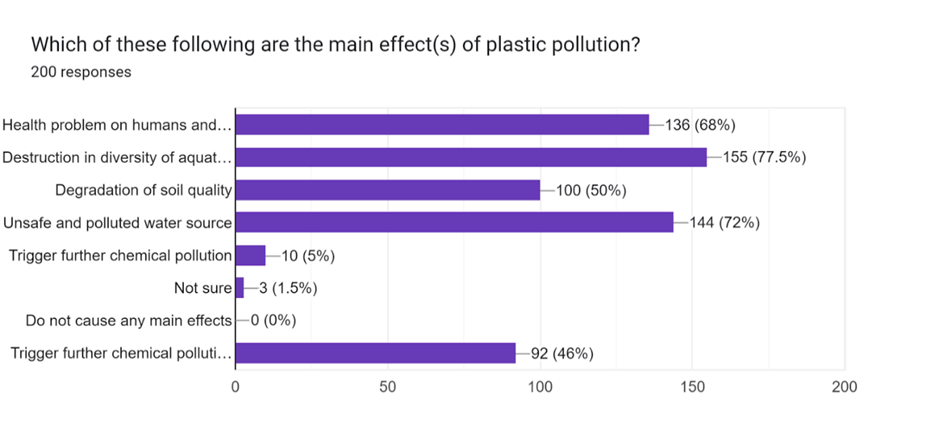
Figure 11: Bar chart showing the respondents’ answer on the effects of plastic pollution
Most respondents chose that water pollution can give effect to the diversity of aquatic organism from fishes, amphibians, plants which are vital for the ecosystem with 77.5% while the do not cause any harm got 0 vote.
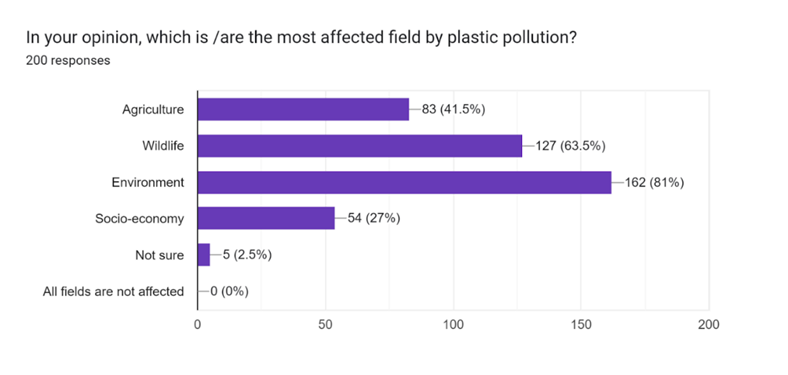
Figure 12: Bar chart showing the stats of respondents’ opinion on which sector is the most affected by plastic pollution
About 81% of respondents stated that our environment is the most affected by the plastic pollution and second most voted option is the wildlife aspect with 63.5%.

Figure 13: Bar chart showing the respondents’ knowledge that is the plastic pollution problem thoroughly solved by the authorities
A total of 93 respondents voted fairly agreed that the authorities have been solving the plastic pollution issue while 9% strongly disagreed.

Figure 14: Bar chart showing the percentage of respondents’ answer whether the authorities need to enforce tighter rules and laws for better plastic waste and pollution management?
Most of the respondents strongly agreed that the authorities need to implement a tighter rule since it has the highest percentage of 61%.
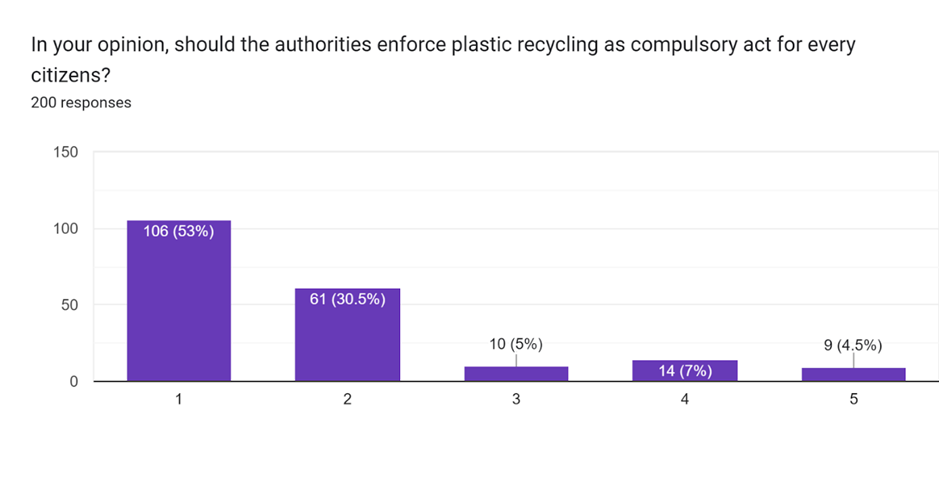
Figure 15: Bar chart showing the respondents’ answer whether the authorities should enforce plastic recycling as a compulsory act for every citizen?
More than half respondents strongly agree that the government should force citizens to start plastic recycling as a daily routine since it has the highest percentage of 53% while 9 respondents strongly disagree.
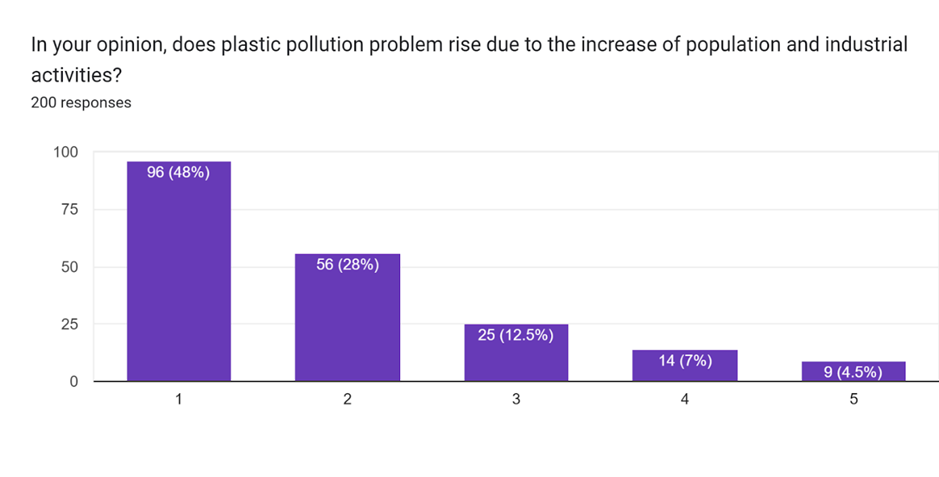
Figure 16: Bar chart showing the percentage of respondents’ opinion that the plastic pollution problem rises due to the increase of population and industrial activities?
A total of 96 respondents strongly agreed that plastic pollution in Malaysia rises due to the increase of population and industrial activities since the demands for plastic are also increasing.
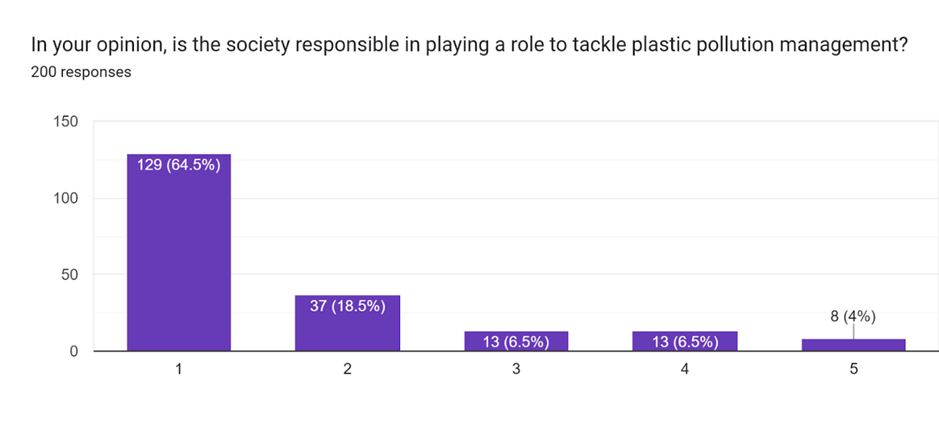
Figure 17: Bar chart showing the respondents’ opinion whether the society is responsible in playing a role to tackle plastic pollution management?
More than half of respondents strongly agree with the statement that society is responsible for playing a role in resolving plastic pollution because it had 129 votes while 8 respondents strongly disagreed.
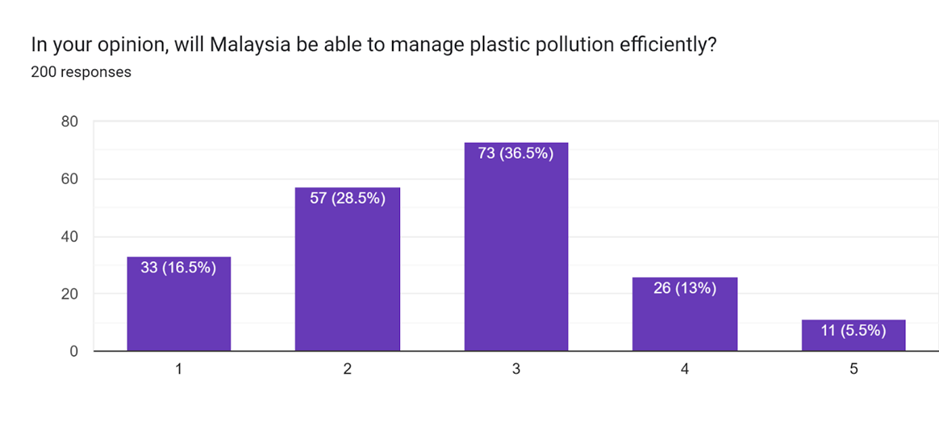
Figure 18: Bar chart showing respondents’ opinion on whether Malaysia will be able to manage plastic pollution efficiently?
A total of 73 respondents fairly agreed with that statement that Malaysia can manage the plastic pollution efficiently in the near future while 11 respondents strongly disagreed with the statement.
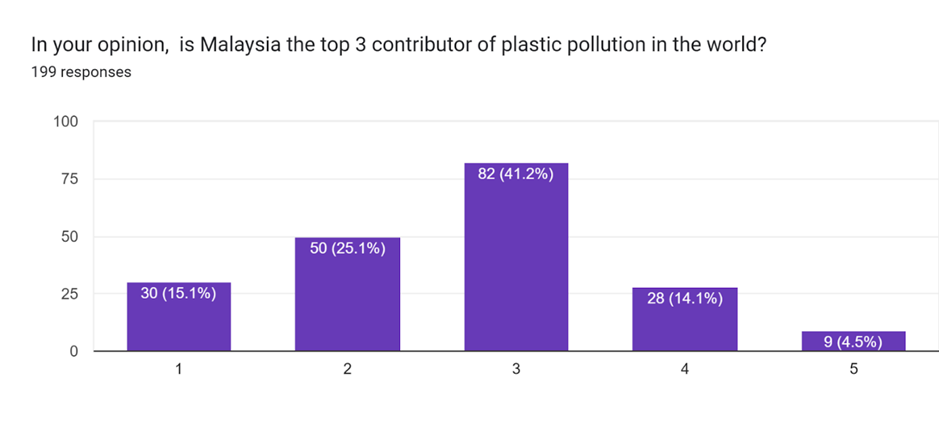
Figure 19: Bar chart showing respondents’ opinion on is Malaysia the top 3 contributor of plastic pollution in the world?
Most of the respondents agreed that Malaysia is the top 3 contributor of plastic pollution in the world but typically Malaysia is not the top 3 ranking because the primary contributor is the country with larger population and less developed waste management.
Section D: Attitudes Towards Plastic Pollution Prevention
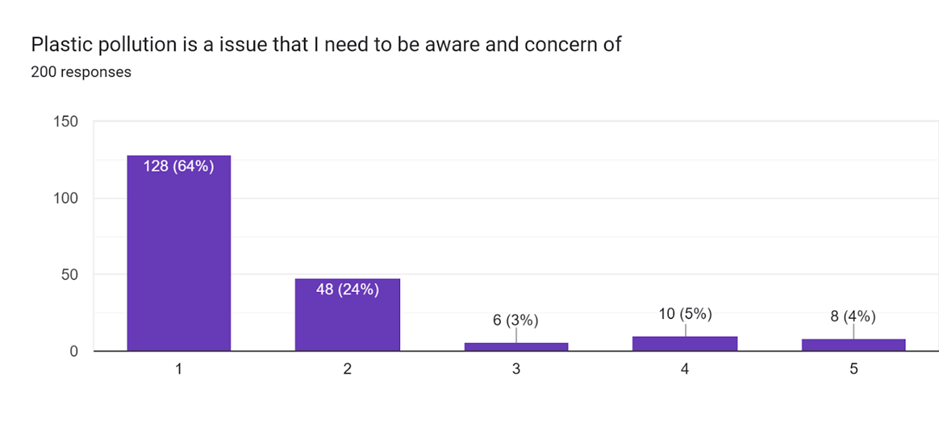
Figure 20: Bar chart showing the respondents’ attitudes on plastic pollution is a issue that I need to be aware and concern of
Most respondents agreed that they need to aware of the plastic pollution issue in Malaysia while 18 respondents did not agree that plastic pollution is not an issue that need to be acknowledge.

Figure 21: Bar chart showing respondents’ willingness to be able to contribute in reducing plastic waste pollution
Most respondents believed that they would be able to contribute to reducing plastic waste pollution by starting to stop using plastic bags in daily use with 110 respondents who strongly agreed.
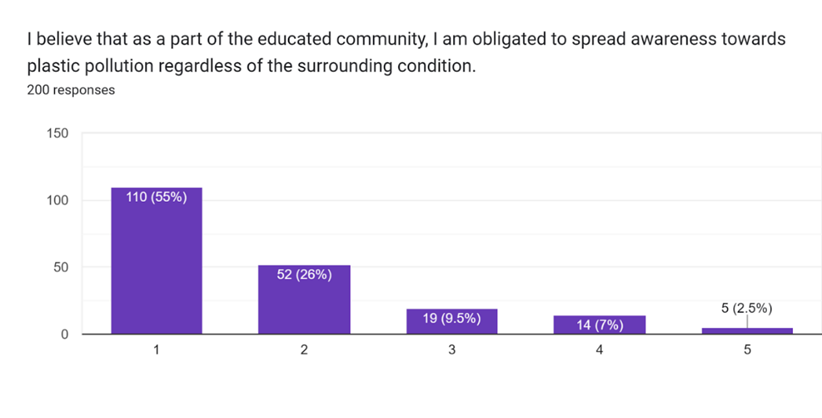
Figure 22: Bar chart showing respondents’ responsibility senses that they can spread awareness about plastic pollution.
A total of 110 respondents believed that they were obligated to spread awareness about the plastic pollution issue in the community of Malaysia regardless surrounding backlash or condition.
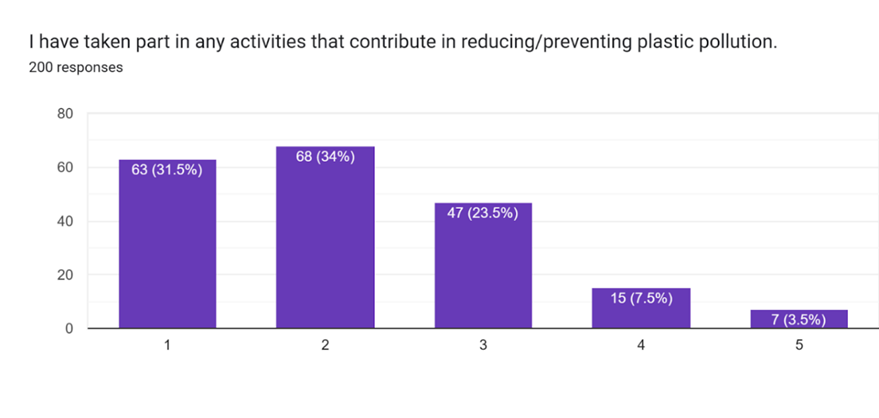
Figure 23: Bar chart showing respondents’ history whether they have taken part in contributing in plastic pollution reduction or prevention.
Most respondents have taken part in any sort of activities that can contribute in plastic pollution reduction and prevention which a total of 178 respondents actively have taken part or responsibility.
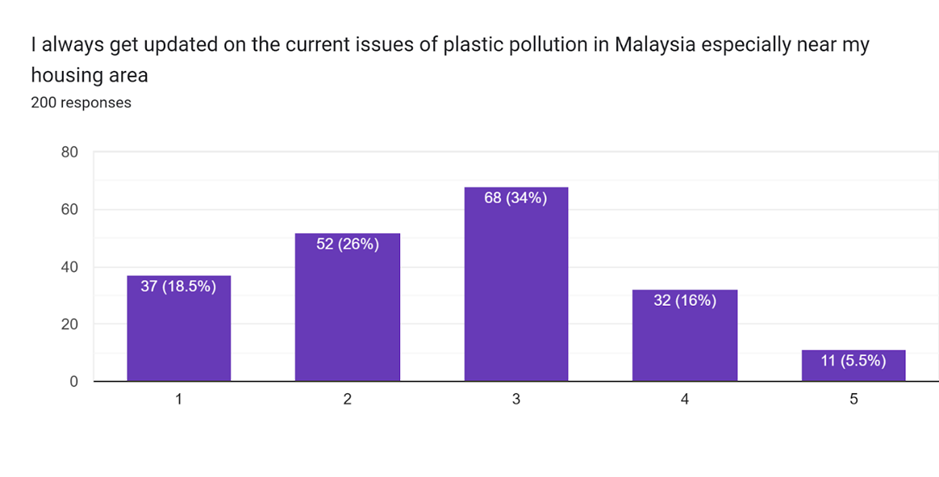
Figure 24: Bar chart showing respondents’ willingness to stay updated on the current issue of plastic pollution in Malaysia
Sixty-eight respondents fairly agreed to stay updated on the current issue of plastic pollution especially near housing area which this could be that there is a little to no media coverage on the daily update of the plastic pollution in every area.
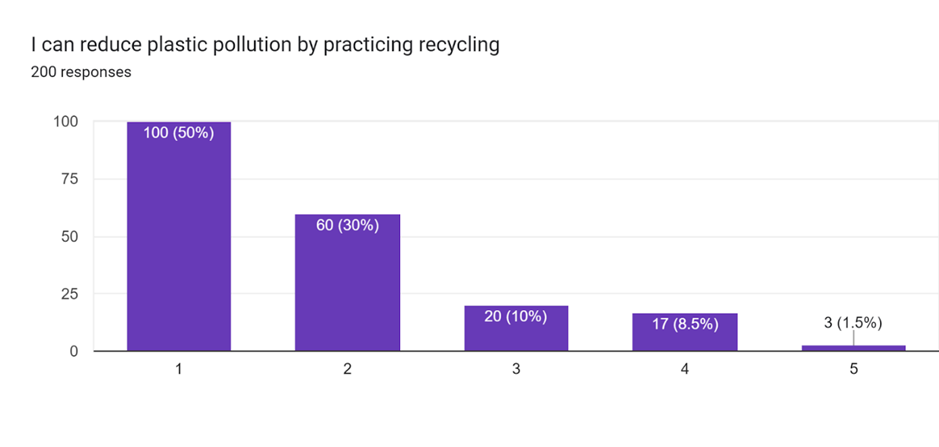
Figure 25: Bar chart showing respondents’ attitude that they can reduce plastic pollution by practicing recycling
A total of 180 respondents stated that they are capable of reducing plastic pollution in the first step by practicing recycling materials like plastic or metal in the household.
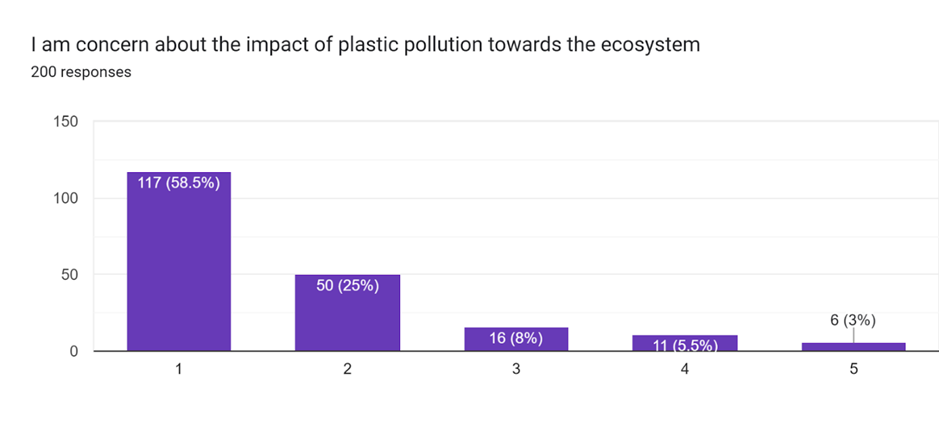
Figure 26: Bar chart showing respondents’ concern about the impact of plastic pollution towards the ecosystem
Most respondents are concerned about the impact of plastic pollution towards the ecosystem which it can harm our wildlife and natural habitat and also accumulation of microplastic in the soil and water because plastic is non-biodegradable.
4. Discussion
4.1 Demographic profile
Most of the respondents ranged from 20 to 20 years old, which is 71.5%. Few respondents were recorded when the age range increased, as more young respondents were reached out from institutions, regardless of whether private or local.113 female and 87 male respondents were recorded, respectively. The majority of the respondents are Chinese (46.0%) and Malay (43.0%), respectively, while the remainder are Indians (4.5%) and other ethnicities (6.5%). Other ethnicities are comprised of indigenous people (orang asli) and foreign students or residents from different nations, such as Thailand, Morocco, and Brunei. Most of the respondents are derived from B40 economy status (62.5%), compared with M40 (29.5%) and T20 (5.0%). This study gained different economic status results compared with Hew et al. (2023), where in his study, B40 comprised 43.7 %, and Sapawi et al. (2023), B40 =40.0%. About 85.0% of respondents have at least studied in university before. While others are categorized as respondents that at least achieved secondary studies and matriculation or equivalent. 63 % of respondents received a science-related study background, such as physics, biology and chemistry. While almost 100 respondents stated that their living area is located in sub-urban areas. These demographics serve as a factor in order to determine the correlation with the respondents’ knowledge and perception of plastic pollution.
4.2. Opinions on plastic pollution
From the table, it is recorded that 97.0 % respondents rated plastic pollution as an environmental issue in Malaysia, while others rated as unsure and disagreed. Most of the respondents agree with the statement above as more plastic-polluted sites were observed and reported from time to time, where study from Fauziah et al (2015) reported that most marine plastic debris are accumulating at coastal areas at Kuala Terengganu. The findings is almost equivalent to a similar study from Hew et al (2023), stating that 97.4% of respondents rated water pollution as an occurring issue in Malaysia, Therefore, it could be concluded that environmental issues are a dilemma for Malaysia netizens. Among the respondents, the perceptions of the top three main causes of plastic pollution are respectively 77.5 %, 74.0%, 56.55% for “littering”, “Inadequate waste disposal and management” and “Industrial development”. Comparatively
with other options of, “Urban and stormwater runoff” and “Sewerage outflow” which are correlated with natural causes, it receives less than 50% of responds, suggesting that plastic pollution is always mainly caused by human activities. For instance, plastic items are disposed improperly by citizens, while plastic and chemical waste are discarded by industrial to land area and limnological ecosystems (Fauziah et al, 2015). Respondents have responded to several main effects of plastic pollution which are; destruction of aquatic systems (77.5%), unsafe and polluted water source (72.0%), health problems (68.0%), trigger further chemical pollution (50.0%) and degradation of soil quality (50.0%). The main effect of plastic pollution is further agreed by current studies from Horie et al (2022). They discovered that plasticizer pollution causes hormone disruption in Japanese medaka fish and will induce health problems by causing gills swelling and stunted growth. There may also be a risk for humans when consuming these polluted biotas. The same studies also showed that it leads to unsafe water sources as in Vietnam and India (Horie et al, 2022). Plastic pollution may also further lead to other chemical pollution, such as heavy metal pollution. None of the respondents view that Malaysia is not affected by plastic pollution, vice versa, most of the respondents (60%) rated that plastic pollution in Malaysia somewhat causes harm in agriculture (41.5%), wildlife (63.5%) and environmental aspects (81.0%). Microplastics are problematic as they could be absorbed in nanoplastics form in agricultural plants and animals. Subsequently, it would be accumulated in the food chain of the whole ecosystem (Tan et al, 2022). While only 27.0 % of respondents, rated that plastic pollution may cause an effect in socio-economy. As plastic wastes are accumulated, it might cause flash floods in rural or city areas, indirectly affecting social life and economic income (Ashizawa et al ,2022).
4.3. Public perceptions and knowledge towards plastic pollution management in Malaysia
The average respondents do not agree thoroughly that the Department of Environment of Malaysia solves plastic pollution, or vice versa. The median rate is 3, which shows that respondents are neutral on this issue. In reality, Malaysia has developed a few national ministries for curbing plastic pollution, such as the National Solid Waste Management Department, the Ministry of Housing and Local Government and the Ministry of Environment and Water (2024). Nevertheless, the effort might not be seen tremendously as plastics are imported and exported in Malaysia more than in Japan, Hong Kong, the United States and Korea (Dominish et al., 2020). Besides, Port Klang in Selangor (Masseran et al., 2023). and Ipoh in Perak are also at risk of developing into a dumping site for international waste, which leads to plastic pollution in Klang River (Masseran et al., 2023). Most respondents agree that the authorities need to enforce much tighter rules and laws to achieve better plastic waste and pollution management. The current penal code, which is Akta Jalan, Parit dan Bangunan 1974 (Akta 133), needs to be revised as the law is far outdated and not strongly enforced, especially by the local authorities. Furthermore, the respondents strongly believe that the authorities should make plastic recycling compulsory for citizens.
Next, the majority of the respondents solely agree that plastic pollution rose due to an increase in population and industrial activities. The response can be attributed to a report by Masseran et al. (2023)) where he reported that the rise of industrial activities in Port Klang had caused the rise in waste products produced in the area. Due to these factors, most respondents believe that society needs to play a vital role in tackling plastic pollution, and 129 respondents strongly agree with the suggestions. Due to the ineffectiveness in tackling the problem, most of the respondents have doubts about whether Malaysia will be able to tackle the problems. This shows that drastic action needs to be taken to restore public trust in our local government's ability to ensure the problem can be solved thoroughly.
4.4. Attitudes towards plastic pollution Prevention
In this section, respondents were tested to determine their attitude towards plastic pollution prevention. The respondents were analysed to determine whether they were aware of the problem and wanted to take action to prevent plastic pollution from continuously happening in their vicinity. From the questions provided to the respondents, the majority are aware and ready to act to ensure that plastic pollution can be successfully tackled. This indicates that with proper guidance and effort by the authorities, plastic pollution in Malaysia can be tackled, thus making Malaysia a leading country in managing plastic pollution.
4.5. Understanding FIKR to the application of personality traits in public perception on plastic pollution
Public perception on plastic pollution varies based on different personality traits of individuals.
a) Facets
Facets of personality such as empathy, environmental consciousness, and concerns for animal welfare can shape an individual's perception of plastic pollution. Individuals with a higher level of facet of conscientiousness are likely to be more aware of the detrimental effects of plastic pollution on marine wildlife and ecosystems, as well as the potential risks of plastic ingestion for human health. Empathy, environmental consciousness, and concerns for animal welfare are significant facets of personality that shape individuals' perception of plastic pollution. People with higher levels of empathy and environmental consciousness tend to be more aware of the detrimental effects of plastic pollution on marine wildlife and ecosystems. They are often motivated to take action and support initiatives aimed at reducing plastic use and promoting proper waste management practices. These individuals are more likely to actively participate in beach clean-ups or advocate for stricter regulations on plastic production and disposal.
b) Insights
Individuals who possess a high level of empathy and environmental consciousness are likely to be more aware of the detrimental effects of plastic pollution on marine wildlife and ecosystems. They may be more motivated to take action and support initiatives aimed at reducing plastic use and promoting proper waste management practices. For example, they may actively participate in beach clean-ups or advocate for stricter regulations on plastic production and disposal. These individuals may actively seek out information and stay informed about the issue of plastic pollution, including its causes, impacts, and potential solutions.
c) Knowledge
Individuals with a higher level of knowledge on the issue of plastic pollution, including its sources, impacts, and potential solutions, are more likely to be concerned about the problem and its consequences. They may have a deeper understanding of the negative effects of plastic pollution on marine species, such as entanglement and ingestion, as well as the potential risks of microplastic ingestion for human health. For instance, they may be aware that plastic debris can accumulate in the food chain, leading to the transfer of microplastics to seafood consumed by humans, thereby posing potential health risks. A comprehensive understanding of plastic pollution, including its sources, impacts, and potential solutions, is crucial in shaping public perception of the issue Moreover, knowledge plays a pivotal role in shaping public perception of plastic pollution. Individuals with a comprehensive understanding of the issue, including its sources, impacts, and potential solutions, are more likely to be concerned about the problem and its consequences. A deeper understanding of the negative effects of plastic pollution on marine species, as well as the potential risks of microplastic ingestion for human health, can significantly impact an individual's perception and drive them towards proactive measures to address the issue.
d) Resilience
Individuals who possess resilience as a personality trait may be more inclined to take action and persevere in the face of plastic pollution challenges. They may not be deterred by the complexity of the issue or the barriers to finding effective solutions, such as economic incentives for plastic use, inadequate waste management systems, or societal norms around single-use plastics. For example, they may actively seek out alternatives to single-use plastics in their daily lives, even if it requires extra effort or cost. These individuals may also be resilient in their efforts to raise awareness and advocate for change, even when faced with skepticism or resistance from others. Overall, the public perception of plastic pollution is likely to be influenced by a combination of these personality traits. Additionally, individuals who possess resilience as a personality trait may be more inclined to take action and persevere in the face of plastic pollution challenges. They may not be deterred by the complexity of the issue or the barriers to finding effective solutions, such as economic incentives for plastic use, inadequate waste management systems, or societal norms around single-use plastics. For example, they may actively seek out alternatives to single-use plastics in their daily lives, even if it requires extra effort or cost. These individuals may also be resilient in their efforts to raise awareness and advocate for change, even when faced with skepticism or resistance from others. Overall, the public perception of plastic pollution is likely to be influenced by a combination of these personality traits. The public perception of plastic pollution is a complex and multifaceted issue that is influenced by a combination of various personality traits. Understanding the relationship between personality traits and perceptions of plastic pollution is crucial for developing effective strategies to address this global challenge [13-16]. Overall, the public perception of plastic pollution is a result of the interplay of these personality traits, and addressing this issue requires a deep understanding of the diverse factors that influence public attitudes and behaviors. It is important to note that while there are individuals who are highly concerned and engaged in addressing plastic pollution, there may still be a significant portion of the population with limited awareness or understanding of the issue [17-20]. This lack of awareness can be addressed through education and awareness campaigns that emphasize the environmental and health impacts of plastic pollution, as well as the potential solutions available to individuals and communities. These campaigns should also highlight the collective responsibility of individuals, businesses, and governments in tackling plastic pollution and emphasize that everyone has a role to play in creating a sustainable and plastic-free future [21-25]. It is important to recognize that the impacts of plastic pollution are far-reaching, affecting not only the environment and wildlife but also human health and the economy. From physical interactions with wildlife, such as entanglement and ingestion, to economic burdens such as clean-up expenses and lost tourism revenue, the consequences of plastic pollution are significant and demand proactive measures [26-28]. Efforts to address plastic pollution must involve a multi-faceted approach, encompassing individual actions, corporate responsibility, and governmental policies. By fostering a deeper understanding of the issue and its far-reaching impacts, and by promoting resilience and proactive engagement, we can work together to create a sustainable and plastic-free future for the benefit of our planet and all its inhabitants. It is important to recognize that the impacts of plastic pollution are far-reaching, affecting not only the environment and wildlife but also human health and the economy. Public perception on plastic pollution is strongly influenced by factors such as personal traits, access to accurate information, and effective communication strategies [27-30].
Conclusion
In conclusion, public perception of plastic pollution evolves as awareness of the issue grows. Even while there is still more work to be done in changing consumer behaviour and reducing plastic waste, it is evident that more people are becoming aware of the harm plastic pollution causes to the environment and are taking action to overcome it. With ongoing campaigning and education, there is hope for a change toward more sustainable habits and a cleaner, healthier earth for future generations. Governments, communities, and individuals must work together to solve this urgent problem and develop ideas that will positively impact the environment. The public perception of plastic pollution is influenced by personality traits such as facet, insight, knowledge, and resilience. This, combined with access to accurate information and effective communication strategies, can help shape public perception towards a greater concern for plastic pollution and drive individuals towards sustainable actions and behaviours. Various factors, including the impacts of plastic pollution on the environment, human health, and the economy influence the public perception of plastic pollution. These impacts range from physical interactions with wildlife, such as entanglement and ingestion, to economic burdens, such as clean-up expenses and lost tourism revenue.
Conflict of interest
There is no conflict of interest for this study
References
- Vadera, S., & Khan, S. (2021). A critical analysis of the rising global demand of plastics and its adverse impact on environmental sustainability. Journal Environment. Pollution. Management 3, 105
View at Publisher | View at Google Scholar - Wee, M. X., Chin, B. L., Saptoro, A., Yiin, C. L., Chew, J. J., Sunarso, J. et al. (2023). A review on co-pyrolysis of agriculture biomass and disposable medical face mask waste for green fuel production: recent advances and thermo-kinetic models. Frontiers of Chemical Science and Engineering, 1-21.
View at Publisher | View at Google Scholar - Chen, Y., Awasthi, A. K., Wei, F., Tan, Q., & Li, J. (2021). Single-use plastics: Production, usage, disposal, and adverse impacts. Science of the total environment, 752, 141772.
View at Publisher | View at Google Scholar - Chin, C. K. K., Mahanta, J., & Nath, T. K. (2023). Knowledge, Attitude, and Practices toward Plastic Pollution among Malaysians: Implications for Minimizing Plastic Use and Pollution. Sustainability, 15(2), 1164.
View at Publisher | View at Google Scholar - Kamarudin, S. H., Rayung, M., Abu, F., Ahmad, S., Fadil, F., Karim, A. A. et al. (2022). Mat Desa, MSZ; Mohd Basri, MS; et al. A Review on Antimicrobial Packaging from Biodegradable Polymer Composites. Polymers, 14, 174
View at Publisher | View at Google Scholar - Ashizawa, T., Sudo, N., & Yamamoto, H. (2022). How Do Floods Affect the Economy? An Empirical Analysis using Japanese Flood Data (No. 22-E-6). Bank of Japan.
View at Publisher | View at Google Scholar - Dominish, E., Retamal, M., Wakefield-Rann, R., & Florin, N. (2020). Environmentally Responsible Trade in Waste Plastic Report 1: Investigating the Links between Trade and Marine Plastic Pollution. Institute for Sustainable Futures.
View at Publisher | View at Google Scholar - Fauziah, S. H., Liyana, I. A., & Agamuthu, P. (2015). Plastic debris in the coastal environment: The invincible threat? Abundance of buried plastic debris on Malaysian beaches. Waste Management & Research, 33(9), 812-821.
View at Publisher | View at Google Scholar - Government Policies. (2024). National Solid Waste Management Policy, https://www.malaysia.gov.my/portal/content/30913 ,retrieved from 16 Feb 2024
View at Publisher | View at Google Scholar - Horie, Y., Yap, C. K., & Okamura, H. (2022). Developmental toxicity and thyroid hormone-disrupting effects of acetyl tributyl citrate in zebrafish and Japanese medaka. Journal of Hazardous Materials Advances, 8, 100199.
View at Publisher | View at Google Scholar - MASSERAN, N., TAJUDDIN, R. R. M., & LATIF, M. T. (2023). Classifying Severity of Unhealthy Air Pollution Events in Malaysia: A Decision Tree Model. Sains Malaysiana, 52(10), 2971-2983.
View at Publisher | View at Google Scholar - Tan, Y., Dai, J., Wu, X., Wu, S., & Zhang, J. (2022). Characteristics, occurrence and fate of non-point source microplastic pollution in aquatic environments. Journal of Cleaner Production, 341, 130766.
View at Publisher | View at Google Scholar - Avio, C G., Gorbi, S., & Regoli, F. (2017, July 1). Plastics and microplastics in the oceans: From emerging pollutants to emerged threat. https://doi.org/10.1016/j.marenvres.2016.05.012
View at Publisher | View at Google Scholar - Barnes, D K A., Galgani, F., Thompson, R C., & Barlaz, M A. (2009, July 27). Accumulation and fragmentation of plastic debris in global environments. Philosophical transactions - Royal Society. Biological sciences, 364(1526), 1985-1998.
View at Publisher | View at Google Scholar - Bellasi, A., Binda, G., Pozzi, A., Galafassi, S., Volta, P., & Bettinetti, R. (2020). Microplastic Contamination in Freshwater Environments: A Review, Focusing on Interactions with Sediments and Benthic Organisms.
View at Publisher | View at Google Scholar - Borrelle, S B., Ringma, J., Law, K L., Monnahan, C C., Lebreton, L. et al. (2020). Predicted growth in plastic waste exceeds efforts to mitigate plastic pollution.
View at Publisher | View at Google Scholar - Diana, Z., Virdin, J., Valiyaveettil, S., Li, H., & Rittschof, D. (2023). Editorial: Emerging challenges and solutions for plastic pollution. Frontiers in marine science, 10.
View at Publisher | View at Google Scholar - Geyer, R., Jambeck, J R., & Law, K L. (2017). Production, use, and fate of all plastics ever made.
View at Publisher | View at Google Scholar - Hartmann, N B., Hüffer, T., Thompson, R C., Hassellöv, M., Verschoor, A. et al. (2019, January 4). Are We Speaking the Same Language? Recommendations for a Definition and Categorization Framework for Plastic Debris. Environmental science & technology, 53(3), 1039-1047.
View at Publisher | View at Google Scholar - Koelmans, A A., Besseling, E., Foekema, E., Kooi, M., Mintenig, S M. et al. (2017). Risks of Plastic Debris: Unravelling Fact, Opinion, Perception, and Belief. Environmental Science & Technology, 51(20), 11513-11519.
View at Publisher | View at Google Scholar - Lau, W W Y., Shiran, Y., Bailey, R M., Cook, E., Stuchtey, M. et al. (2020). Evaluating scenarios toward zero plastic pollution.
View at Publisher | View at Google Scholar - Musah, B I., Peng, L., & Xu, Y. (2021). Plastic waste menace in Ghana, a serious threat to marine ecological diversity.
View at Publisher | View at Google Scholar - Öztürk, R Ç., & Altınok, İ. (2020). Interaction of Plastics with Marine Species.
View at Publisher | View at Google Scholar - Pilapitiya, P N T., & Ratnayake, A S. (2024). The world of plastic waste: a review. Cleaner materials, 100220-100220.
View at Publisher | View at Google Scholar - Prabhu, P P., Pan, K., & Krishnan, J N. (2022). Microplastics: Global occurrence, impact, characteristics and sorting.
View at Publisher | View at Google Scholar - Reddy, C S., Ghai, R., Rashmi, R., & Kalia, V C. (2003). Polyhydroxyalkanoates: an overview.
View at Publisher | View at Google Scholar - Rhodes, C J. (2018). Plastic Pollution and Potential Solutions.
View at Publisher | View at Google Scholar - Veidis, E M., LaBeaud, A D., Phillips, A A., & Barry, M. (2022). Tackling the Ubiquity of Plastic Waste for Human and Planetary Health.
View at Publisher | View at Google Scholar - Welden, N. (2020). The environmental impacts of plastic pollution.
View at Publisher | View at Google Scholar - Worm, B., Lotze, H K., Jubinville, I., Wilcox, C., & Jambeck, J. (2017). Plastic as a Persistent Marine Pollutant. Annual Review of Environment and Resources, 42(1), 1-26.
View at Publisher | View at Google Scholar - Hew, T. Y. A., Yap, C. K., Azhar, M. E. S., Defififaldi, M., Chew, J. M. et al. (2023). Perception of water pollution among Malaysian university students: A case study. Sustainable Social Development, 1(2).
View at Publisher | View at Google Scholar - Sapawi, D. K. A., Chew, J. M., Shahidah, D. N., Rahman, M. N. A., Zulkifli, I., Hew, T. Y. A. et al. (2023). Public perception of flood risks in Klang Valley, Malaysia: A case study. Sustainable Social Development, 1(2).
View at Publisher | View at Google Scholar

 Clinic
Clinic
